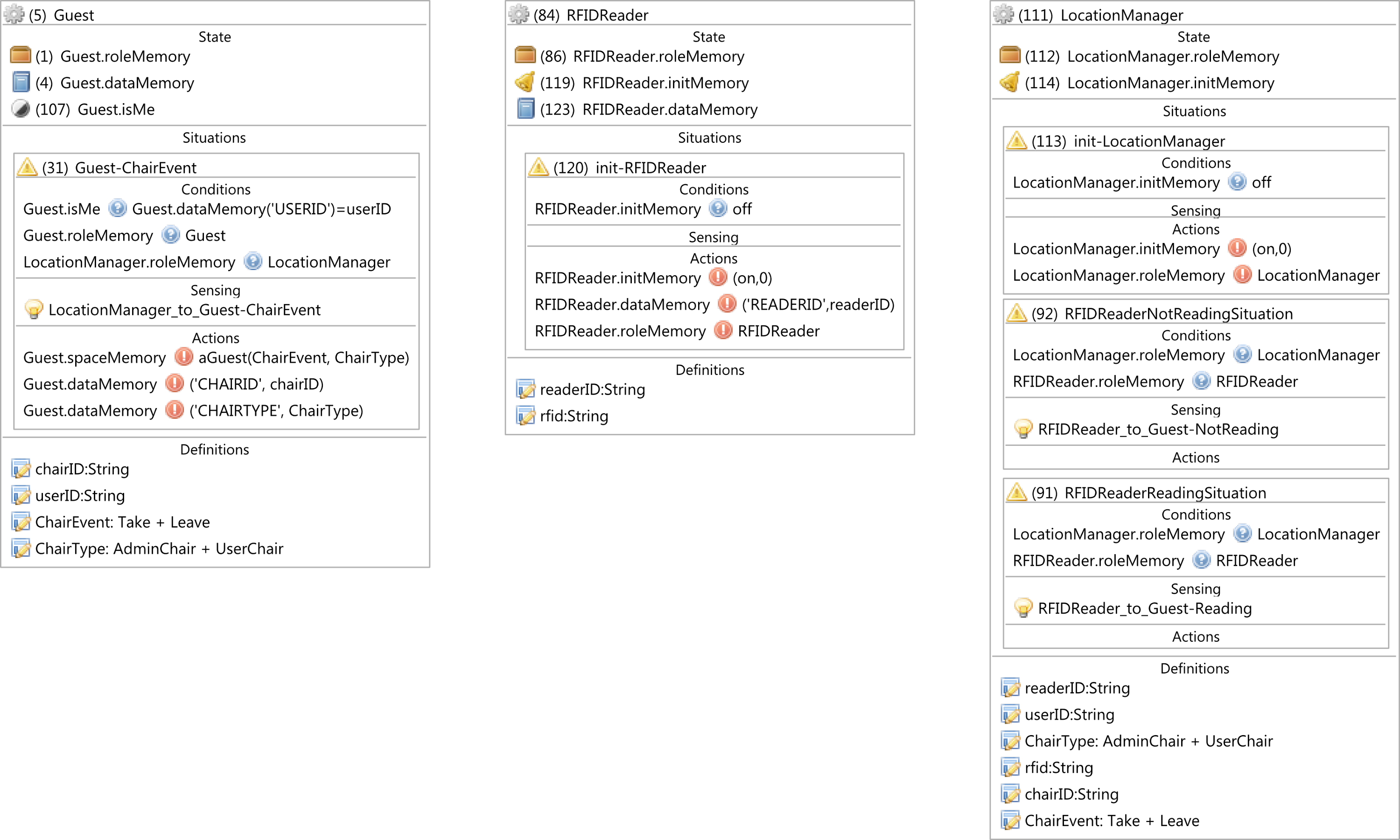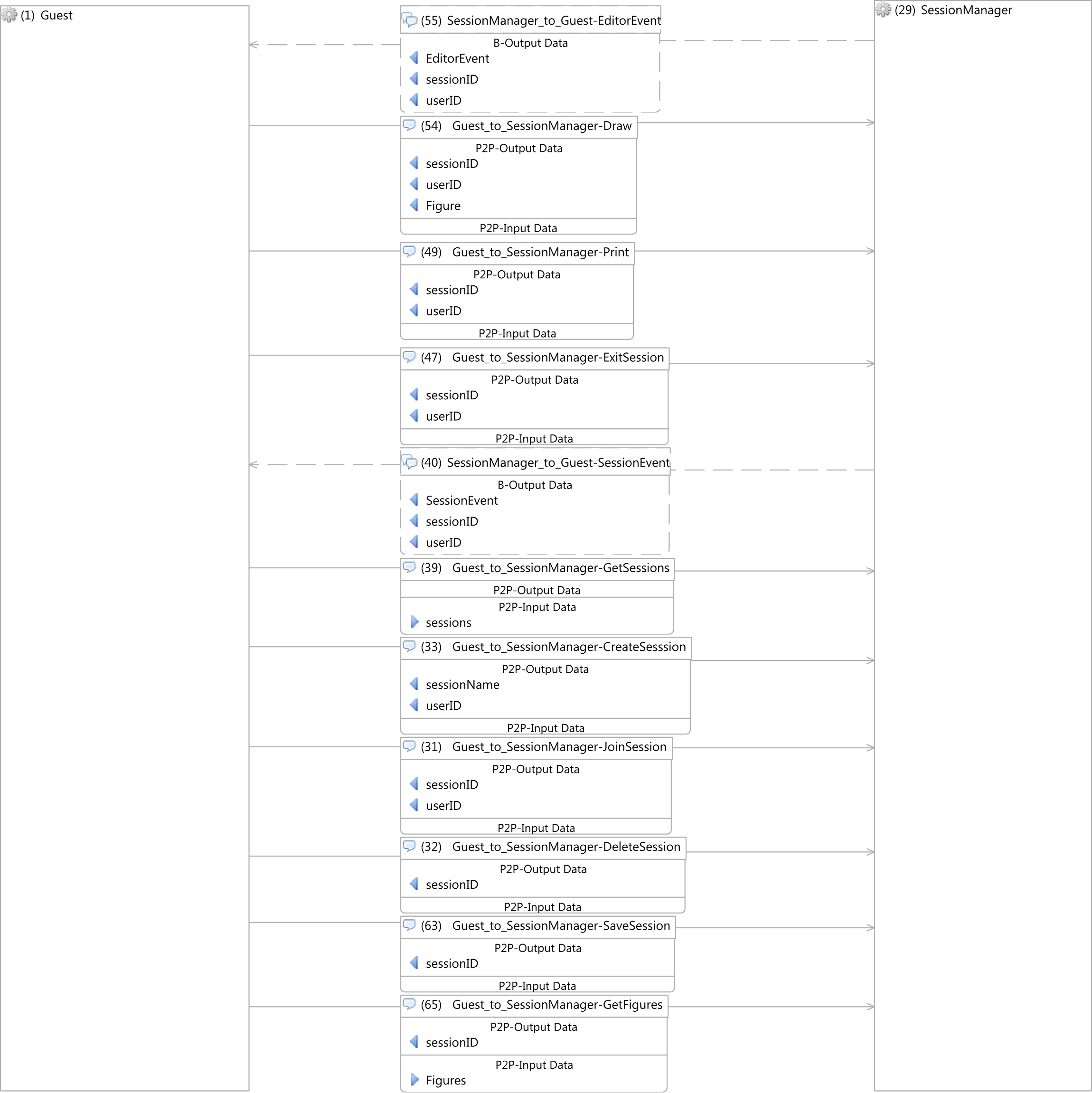As result of the ATL M2M CIM to PIM transformation process, you get the space reference, information flow and entity context model depicted in Figure 94, Figure 95 and Figure 96.
Referential space model
The referential space model (Figure 94) defines 4 sets of entity references:
- The Guest group is composed by a single entity reference that represents the set of users in the system.
- The chair group is composed by the Chair, AdminChair and UserChair entity references. This chair group entity references provides a mechanism to assign a role to a user. Besides, each reference represent a chair that is used by users to log in into the system, as each user has his/her own chair, they are defined with the many cardinality.
- The session control group is defined by the CreateControl, DeleteControl and JoinControl entity references. Each reference represent the set of controls each user is able to interact with after the user logs in and before he/she joins a session, as each user has his/her own controls they are defined with the many cardinality.
- The editor control group is defined by the PrintControl, SaveControl , ExitSessionControl and Canvas entity references. As in session controls, each reference represent the set of controls each user is able to interact with after the user joined a session. Besides, as each user has his/her own controls they are defined with the many cardinality.

Information flow model
The information flow model (Figure 95) is composed by two types of entities: execution and sensor entities. On the one hand, the Guest entity is the only execution entity. It is responsible for processing information brought from the environment through sensor entities. In addition, it is in charge of executing system tasks. On the other hand, the sensor entities provide information to execution entities from the environment.
UserChair and AdminChair produce data according to the events defined on the task model (take and leave). These events are transported through the UserChair-Chair and AdminChair-Chair information flows from the UserChair and AdminChair entities respectively to the Chair entity. Subsequently, they are forwarded to the Guest entity through the Chair2GuestEvent information flow.
The JoinControl, CreateControl and DeleteControl entities define the released event, that occurs when the control is activated notifying the released event to the Guest entity to perform the required action accordingly.
- The JoinControl sends the released data through the JoinControl2GuestEvent when the entity detects that a user wants to join a session
- The CreateControl sends the released data through the CreateControl2GuestEvent when the entity detects that an administrator wants to create a session
- The CreateControl sends the released data through the DeleteControl2GuestEvent when the entity detects that an administrator wants to create a session
The PrintControl, SaveControl, ExitSessionControl and Canvas entities define the released event. Besides the Canvas notifies two more events (move and pressed) that should be processed by the Guest entity.
- The PrintControl sends the released data through the PrintControl2GuestEvent when the entity detects that a user wants to print the current drawing (session content)
- The SaveControl sends the released data through the SaveControl2GuestEvent when the entity detects that a user wants to save changes on the current session
- The ExitSessionControl sends the released data through the ExitSessionControl2GuestEvent when the entity detects that a user wants to exit current session
- The Canvas entity defines the Canvas2GuestEvent information flow to send 3 types of events:
- The pressed data is sent through the Canvas2GuestEvent when a user starts drawing on the canvas
- The move data is sent through the Canvas2GuestEvent when a user is currently drawing on the canvas
- The released data is sent through the Canvas2GuestEvent when a user stops drawing on the canvas
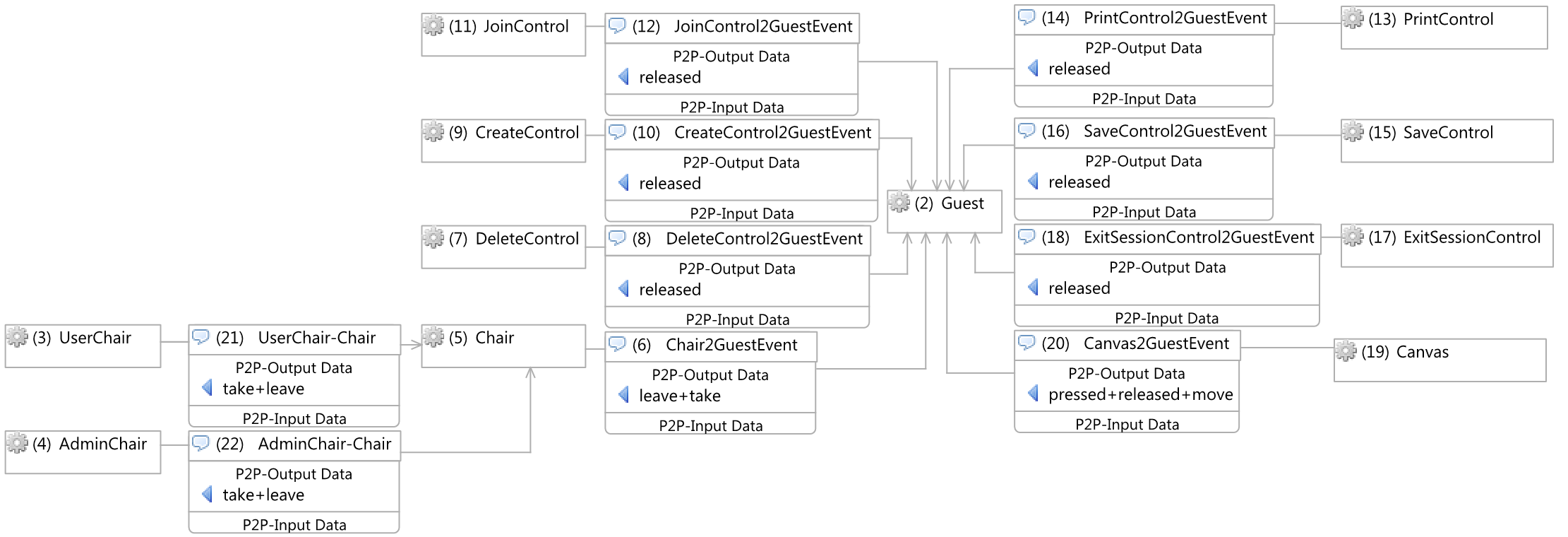
Entity context model
The entity context model contains information that describes entities defined on the referential space and information flow models.
The Guest entity context representing the context of the homonymous entity. It is in charge of capturing changes from the environment and defining situations to execute system tasks.
The UserChair, AdminChair and Chair entity contexts are in charge of pervieving the login and logout actions from users and notifying these events to the Guest entity.
The DeleteControl, CreateControl and JoinControl entity contexts are in charge of perceiving session management actions from users, such as deleting, creating and joining
a session, and notifying these events to the Guest entity.
Finally, the PrintControl, SaveControl, ExitSessionControl and Canvas entity contexts are responsible for perceiving editor actions from users, such as drawing, printing, saving and leaving a
session and notifying these events to the Guest entity.
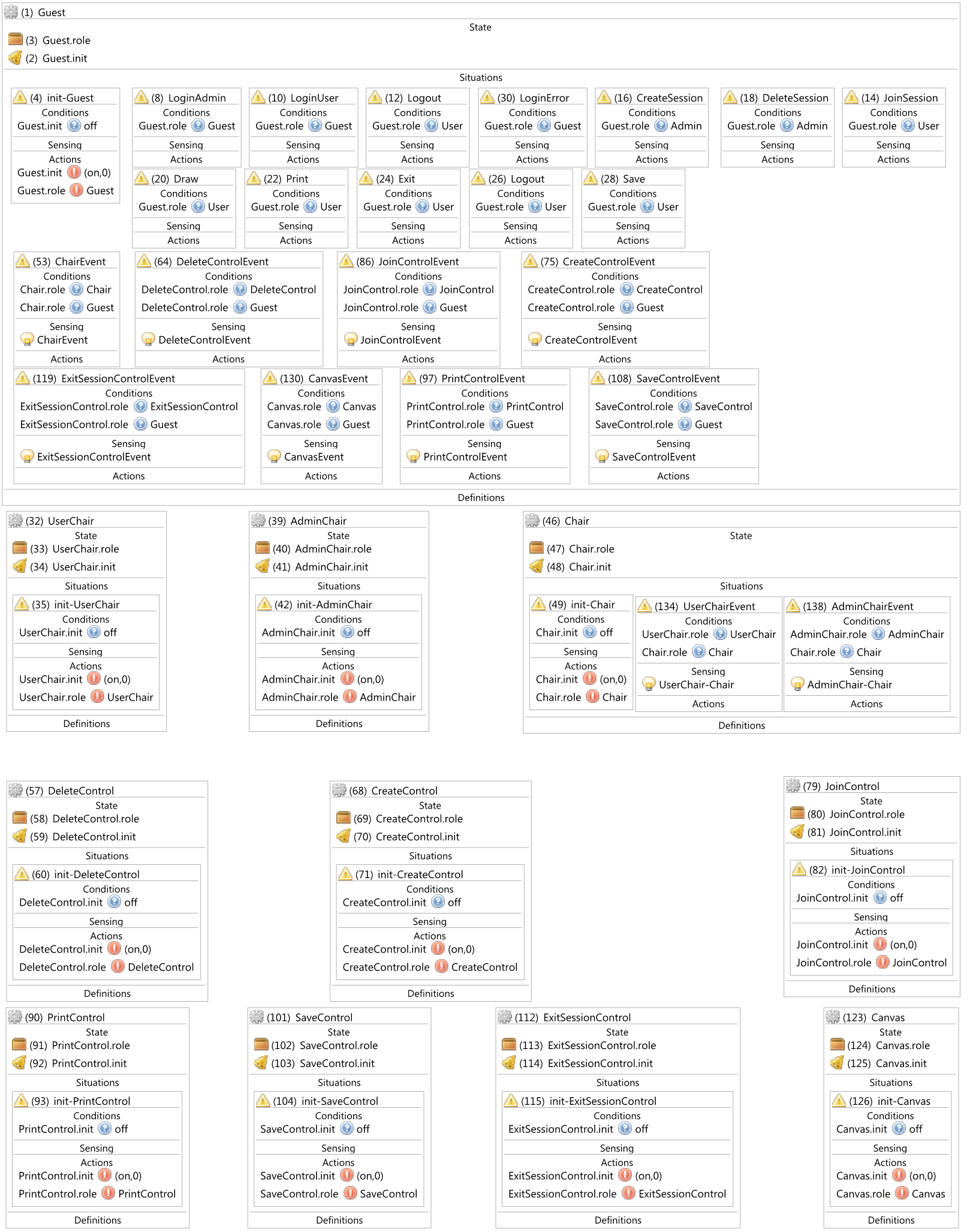
Information delivery and session management
The transformation result information flow and space reference models are not consistent (Guest has a MANY cardinality and Guest has point to point incoming information flows).
Therefore, we introduced the Participant referential space in the referential space model to create work sessions. The result of this modification is depicted on Figure 97.

As result of this modification we have also modified the information flow model as depicted in Figure 98 and the entity context model depicted in Figure 99.
Shared Blackboard Information flow model (modified to support work sessions)
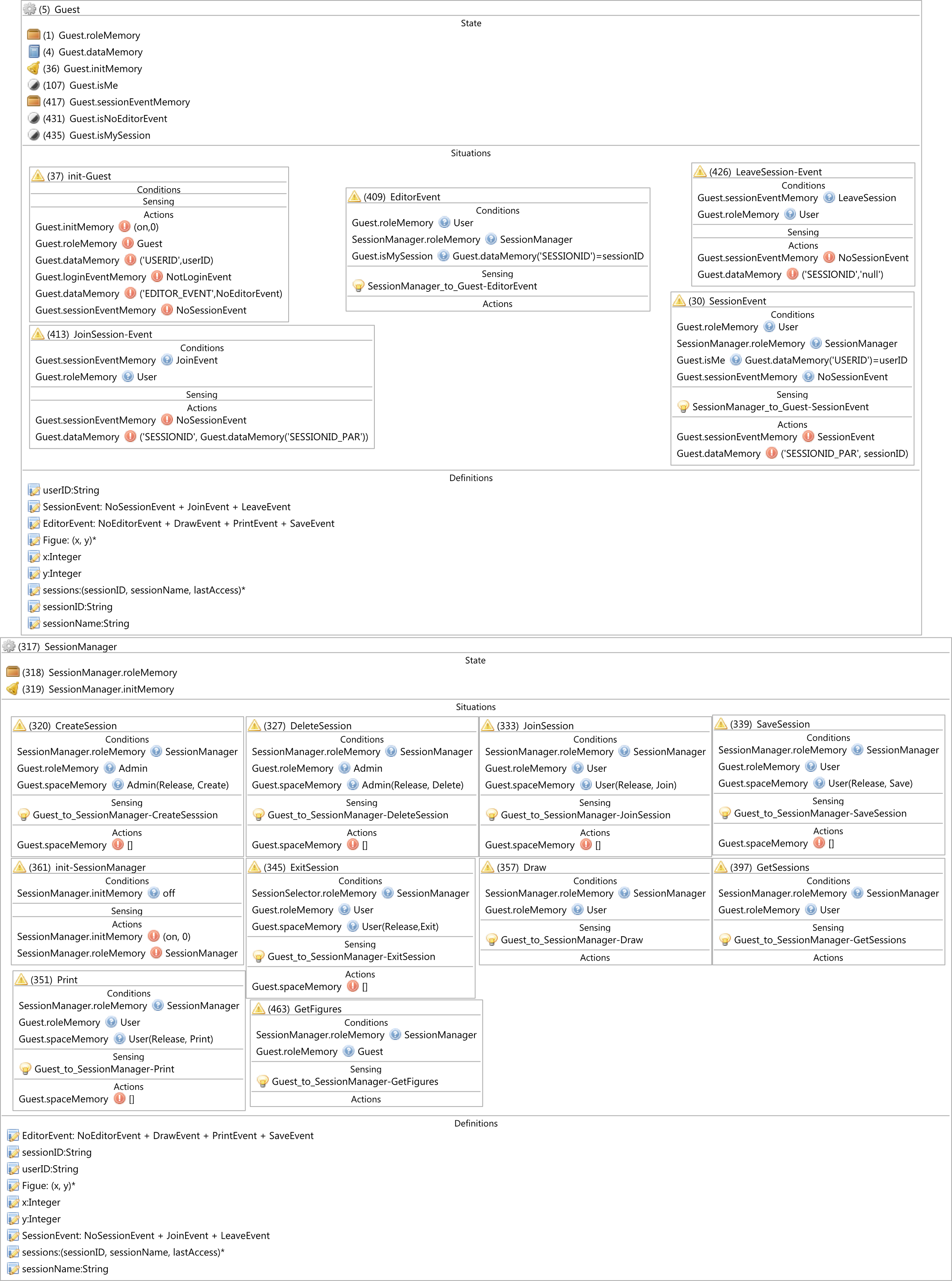
Sensing participants’ location
This section explains how to extend the information flow model to support location awareness. The location relates users to the role being played during a work session.
Therefore, the Chair, UserChair and AdminChair entities are replaced by the RFIDReader entity to identify users. Thus, the userID is coupled to a readerID which identifies the chair the user is sit on. This association is interpreted and stored by the LocationManager. Therefore, the RFIDReader_to_LocationManager-NotReading and the RFIDReader_to_LocationManager-Reading information flows connect the RFIDReade to the LocationManager. Then, the LolocationManager sends information by the means of LocationManager_to_Guest_ChairEvent information flow to the Guests according to the information collected from the RFIDReader and interpreted by the LocationManager. The extension of the information flow model is depicted in Figure 98.

The modification of the information flow model affects the space reference model as depicted in Figure 100.

Finally, the modifications on the entity context model to support location awareness is depicted in Figure 101.
